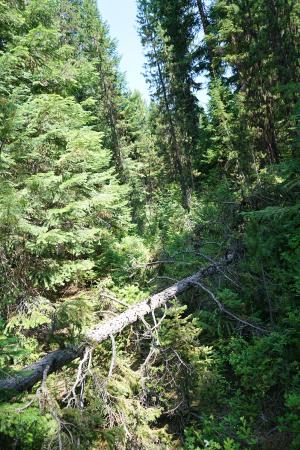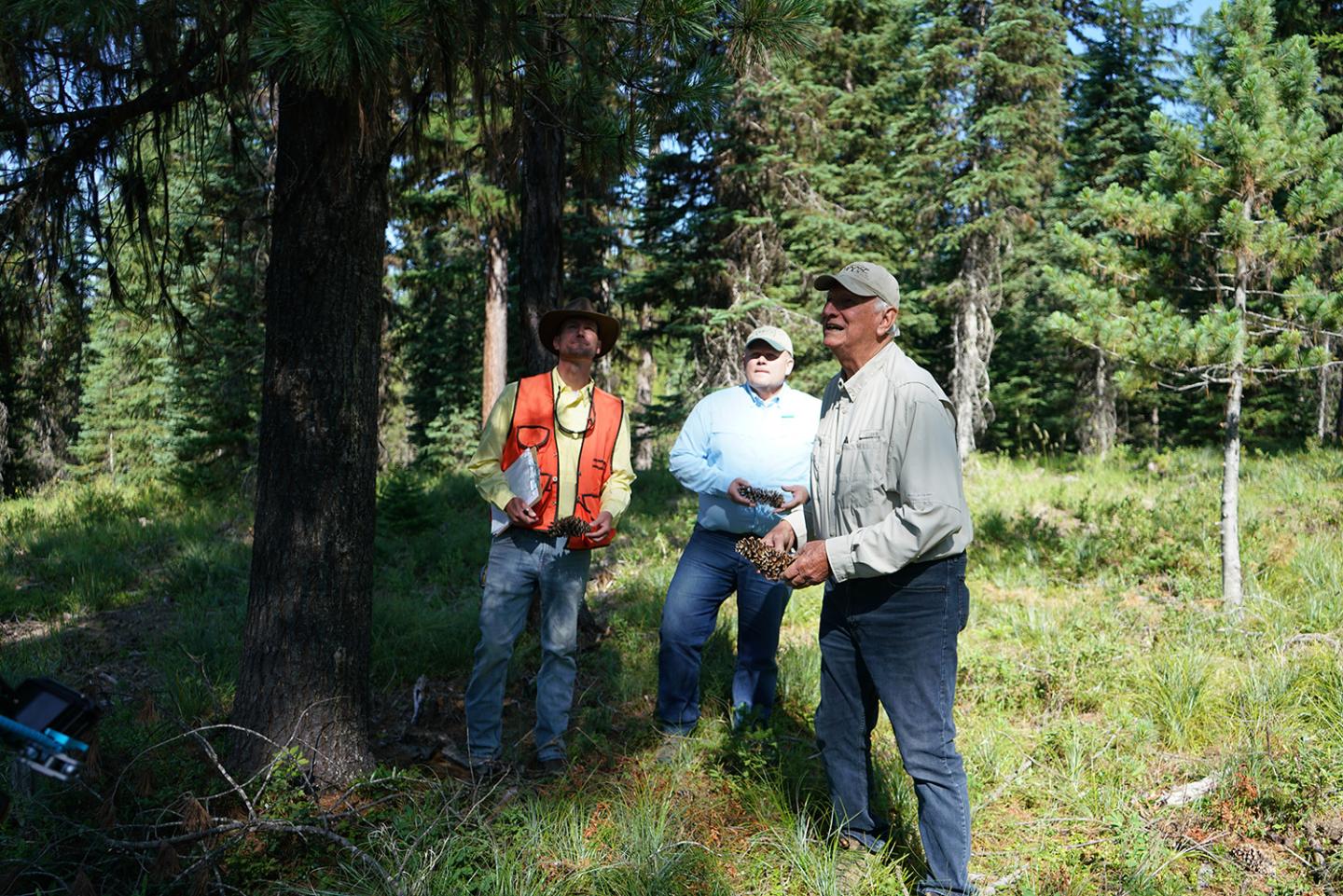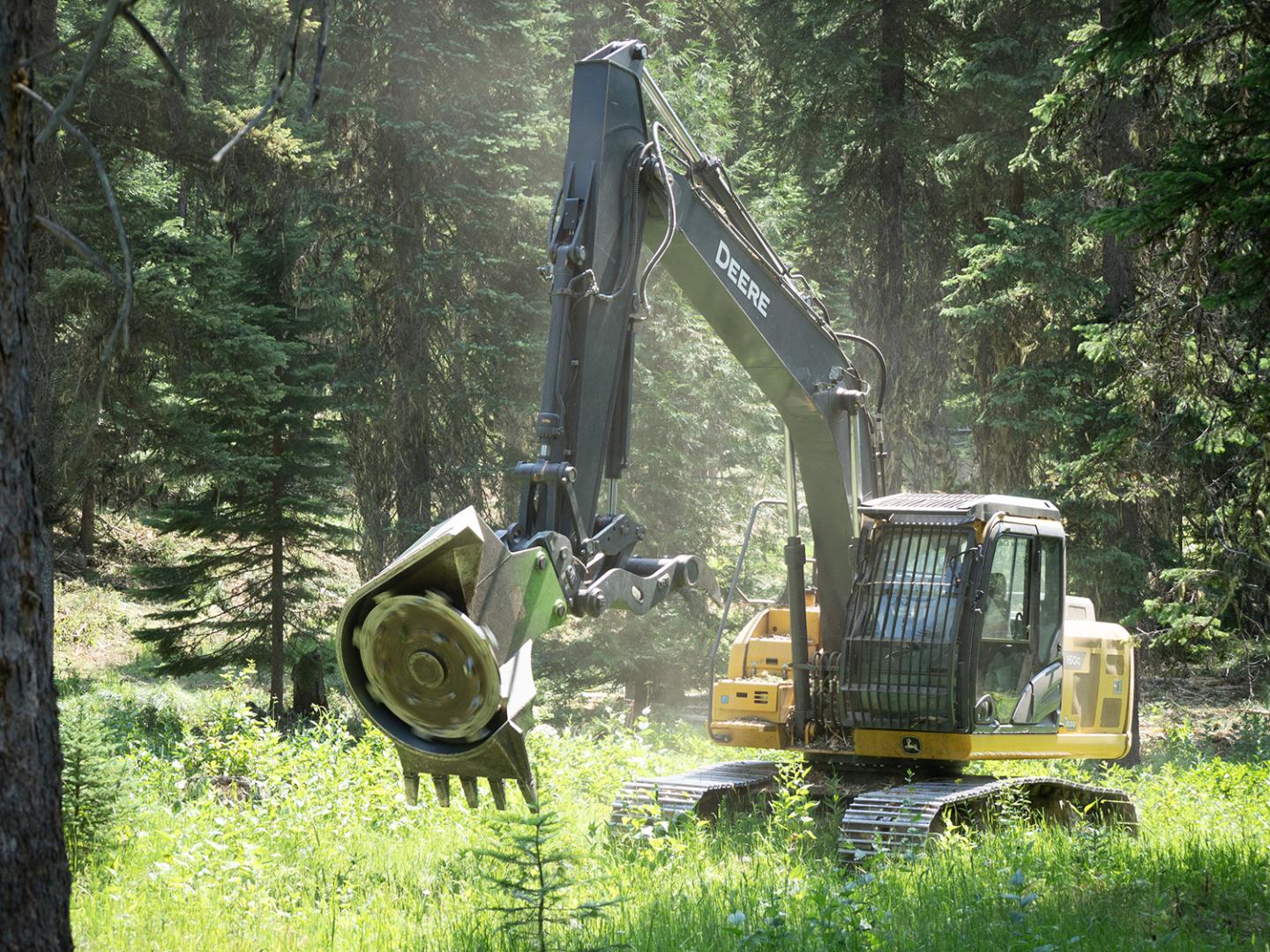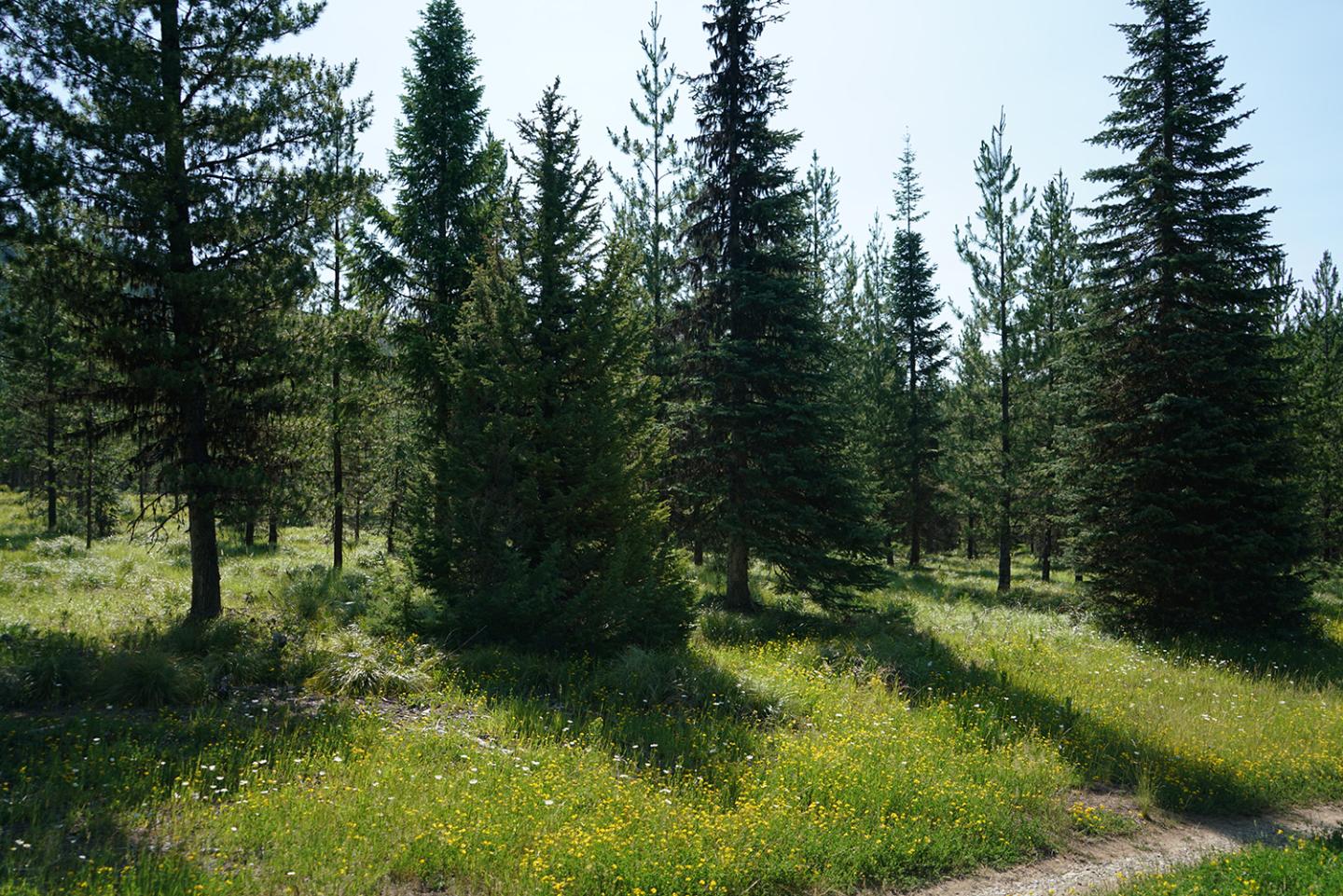Preserving a Legacy: NRCS and Landowners Team Up to Protect a Family Forest

Forest health is a resource concern across Western Montana. NRCS assistance helps many private landowners to treat their forests to maintain healthy stocking rates and species diversity.
Deep in western Montana, a unique and diverse forest is growing strong under the careful stewardship of Charles, a second-generation earth scientist with a profound connection to the land. For nearly six decades, Charles has dedicated his life to preserving the forest his parents purchased 57 years ago. The land, rich in tree diversity and history, has become a sanctuary for Charles and his family—a place where they gather each summer to reconnect with nature and one another.
Charles’ commitment to maintaining the forest’s integrity led him to partner with the USDA Natural Resources Conservation Service (NRCS) after years of trying to manage it alone. “It’s been a family forest to enjoy through the century,” Charles reflects.
A Legacy Born from Fire

The story of Charles’ family forest begins with a tragedy that struck the region long before he was born. In 1910, one of the most catastrophic wildfires in U.S. history swept through the Northern Rockies. Known as the Big Burn, the fire consumed over three million acres of forest across Montana, Idaho, and Washington in just two days.
The devastation left by the fire created a unique opportunity for those willing to restore the land. In 1913, a pioneer homesteaded one of the burned properties, seeing potential for cattle ranching thanks to the open meadow on the property and an economy driven by mining and railroads. However, the property later fell into disrepair, and the county eventually auctioned the land, which was purchased by a couple who sold timber.
Charles’ family learned about the property through his uncle, a wildlife manager with the Forest Service. His parents, who had moved frequently due to his father’s work as a geologist, decided to settle down when his father became a professor. Using earnings from educational books and a teaching salary, they bought the property in 1966. The land was in poor condition due to past logging practices, but his parents, trained in physical sciences, saw its potential and instilled in their children the importance of preserving it.
Since then, Charles has been a devoted steward of the forest, despite not having formal training in biological sciences. He considers it a labor of love, taking pride in being a “gardener of the forest,” a role he cherishes in his retirement. “It’s important to manage the land now to help prevent something similar from happening in the future,” Charles says, reflecting on the devastating 1910 fires.
Facing Forestry Challenges
Over the years, the forest has faced numerous challenges, including increased fuel loads, disease, pests, and drought. These issues, compounded by the struggles of managing forest holdings in a depressed timber market, prompted Charles to seek the knowledge and assistance of experts. “The worst pest infestation we experienced was the lodgepole pine bark beetle in 2005,” Charles recalls. “It looked like someone had rattled the bark with a shotgun. It’s prevalent all through the Rockies and even up into Canada and Alaska.”
The lodgepole pine, a common tree species in Montana, is particularly susceptible to bark beetles. These tiny insects can cause widespread devastation by burrowing into the bark, disrupting the tree’s ability to transport water and nutrients, leading to its death. During drought conditions, the lodgepole pine’s natural defenses against these beetles are weakened, making them even more vulnerable.
Charles shares that he planted 6,500 trees between 2005 and 2006. “You can only plant in the springtime, right after the snow melts, when the soil is really moist and the temperatures are cool. This helps prevent stress on the new seedlings and saplings,” he explains. After obtaining a certified stewardship plan from the Montana Department of Natural Resources in Missoula, they ordered the trees in batches. Charles enlisted the help of three college students on spring break to plant the trees, focusing on areas where the lodgepole pines had been decimated. They planted ponderosa, larch, white pine, and Douglas fir, aiming to maintain a mix of indigenous species.
About four years ago, Charles learned through a neighbor about an opportunity called the Packer Creek Targeted Implementation Plan (TIP). This led to his introduction to NRCS District Conservationist John Bowe, who came out to the forest and began the assessment process. Initial resource concerns included overstocking within the forest and the presence of noxious weeds. “We began planning for a broad-scoped forest management plan,” says Charles.

Bowe explains that the TIP complemented the ongoing Cruzane Mountain Project, a Forest Service-driven series of timber management projects along Forest Service property lines throughout the area. Similarly, the TIP involved pre-commercial thinning, noxious weed treatments, and fuel breaks around cabins and private structures. “This work is important because the private lands are limited but critical to the bigger picture working hand in hand with the Forest Service to address the complete package,” Bowe says.
The work started with technical assistance, as Charles and Bowe inventoried the property and identified opportunities. Charles submitted an application through the Environmental Quality Incentives Program (EQIP), through which the TIP is funded, and they were able to roll it into a financial assistance contract from there.
Thinning and Diversity
One of the key strategies implemented was selective thinning—a process of removing weaker, overcrowded, or diseased trees to reduce competition for resources like sunlight, water, and nutrients. “Trees, like garden plants, need three basic elements: sunshine, water, and nutrients,” explains NRCS Missoula and Mineral County Field Forester Ben Crystal. “Once you thin a forest out, it gives it more sunlight, and it’s not in as much competition for nutrients and water, so it thrives and does much better.”
Thinning is not just about removing trees; it’s about making thoughtful decisions to promote the growth of a healthy and diverse forest.
Charles’ forest is home to a variety of tree species. “Every tree that is indigenous to Montana can almost be found here,” Charles says. He’s counted over 11 species of conifers, including larch, western white pine, ponderosa pine, rocky mountain hemlock, and western hemlock, Engelmann spruce, Douglas fir, grand fir, subalpine fir, western larch, western red cedar, and lodgepole pine. Each species plays a unique role in the forest ecosystem, contributing to its overall health and biodiversity.
Western red cedar, for example, is particularly important. Known for its longevity—some trees can live for over a thousand years—western red cedar is a vital component of the forest’s structure and function. “It’s very important that we identify them when we see them and ensure they're given the space and resources to thrive,” says Crystal.

By thinning the forest and reducing competition, Charles is not only helping individual trees like the western red cedar but also encouraging the regeneration of the understory—young trees, shrubs, and ground cover that are essential for maintaining soil health and providing habitat and food for wildlife. Crystal adds that the work they’ve done on Charles’ 70 acres of contracted land, involving forest stand improvement, was made possible by Montana Focused Conservation. “We care about setting the forest up for a healthy future and removing sick, diseased, and overstocked trees from the understory and midstory,” he says.
Protecting a historic cabin that Charles’ own father restored years ago is important to the family, as it holds deep personal significance. The cabin, along with a beautiful meadow and open park-like area named after his parents, are all treasures at risk in the face of wildfire. The NRCS’s efforts to prevent such disasters are essential to safeguarding these cherished spots.
Pest and Disease Management
In addition to thinning, pest and disease control is another critical aspect of forest management. White pine blister rust, a fungal disease that has ravaged white pine populations across North America, poses a significant threat to the health of Charles’ forest. The disease causes cankers on the branches and trunks of infected trees, eventually girdling and killing them. Left unchecked, white pine blister rust can devastate entire stands of trees, reducing biodiversity and altering the forest’s structure.

To combat this, Charles and the NRCS team have implemented a combination of strategies, including monitoring for signs of infection, removing diseased trees, and promoting the growth of resistant tree species. “We’re doing the inventory work, identifying any potential disease issues, insect issues, in addition to the stocking,” explains Bowe. “That’s the main focus—identifying those big-ticket items.”
The proactive approach taken by Charles and the NRCS in managing pests and diseases has helped safeguard the forest’s health, ensuring it remains a vibrant and diverse ecosystem. This careful management not only protects the trees but also supports the variety of wildlife species that depend on the forest for habitat and food.
Progress Through Partnership
One significant milestone in Charles’ journey with the NRCS was the thinning of the southern facing slope where the trees had seemed to grow especially thick, making it especially susceptible to disease and fire risk. This was a task that required careful planning and execution. “The southern end of the forest was thinned about two years ago, and then earlier this summer, we completed the first unit of the second contract on the other side of the creek,” Charles recalls. The results have been encouraging, with noticeable improvements in the forest’s overall health and resilience.

“We’ve had two winters now since the first treatment. With that much snow and moisture up here, you see the woody residues break down more quickly, and the understory come back more quickly,” Charles observes. The thinning has not only reduced the risk of wildfires by decreasing the fuel load but also allowed the remaining trees to thrive in a less competitive environment. The improved health of the forest is evident in the vibrant new growth and the return of a diverse range of plant species in the understory.
A Family’s Sanctuary
Forestry is a lifelong process, according to Crystal who says that while the initial goal was to come in and get a measure and a pulse on the forest, ongoing monitoring weeds, insects, and disease has been an important part of the plan. “We want to be thinking ten years down the road and double checking those insects and disease. We’re always thinking in the future here on this forest.” Crystal describes Charles as being a hands-on landowner whom he loves working with.
Despite the challenges of managing the forest, Charles remains deeply connected to the land. Every summer, his family makes a point to gather here, cherishing the time spent together in nature. One of the more memorable moments in Charles’ connection with the forest came during an unexpected encounter with its wild residents. “I ran into a cougar while out for an evening walk,” he recalls. “I could see the pink of its nose and the white of its whiskers, just staring at me, ears pointed straight at me.” Though the experience was nerve-wracking, it deepened his bond with the land and its wildlife.
The forest serves as a special place where the family can escape from the hustle and bustle of daily life, reconnect with nature, and strengthen their bond. And as Charles looks to the future, he is hopeful that the steps he has taken with the NRCS will help ensure the forest remains a healthy and thriving ecosystem. “We’re mountain people,” Charles says describing his family. “It’s about preserving what we have and making sure it’s here for future generations.”
Learn More

